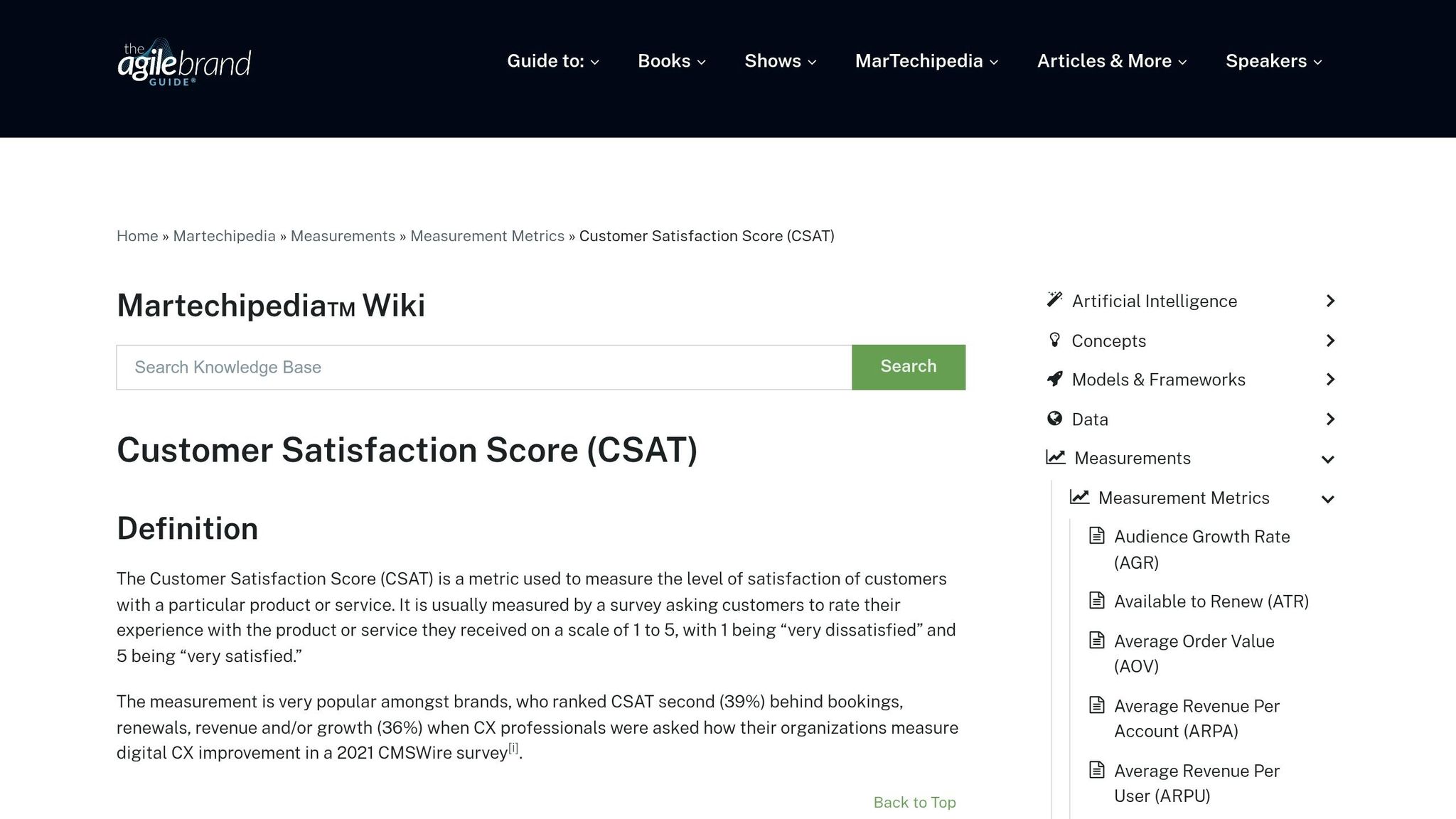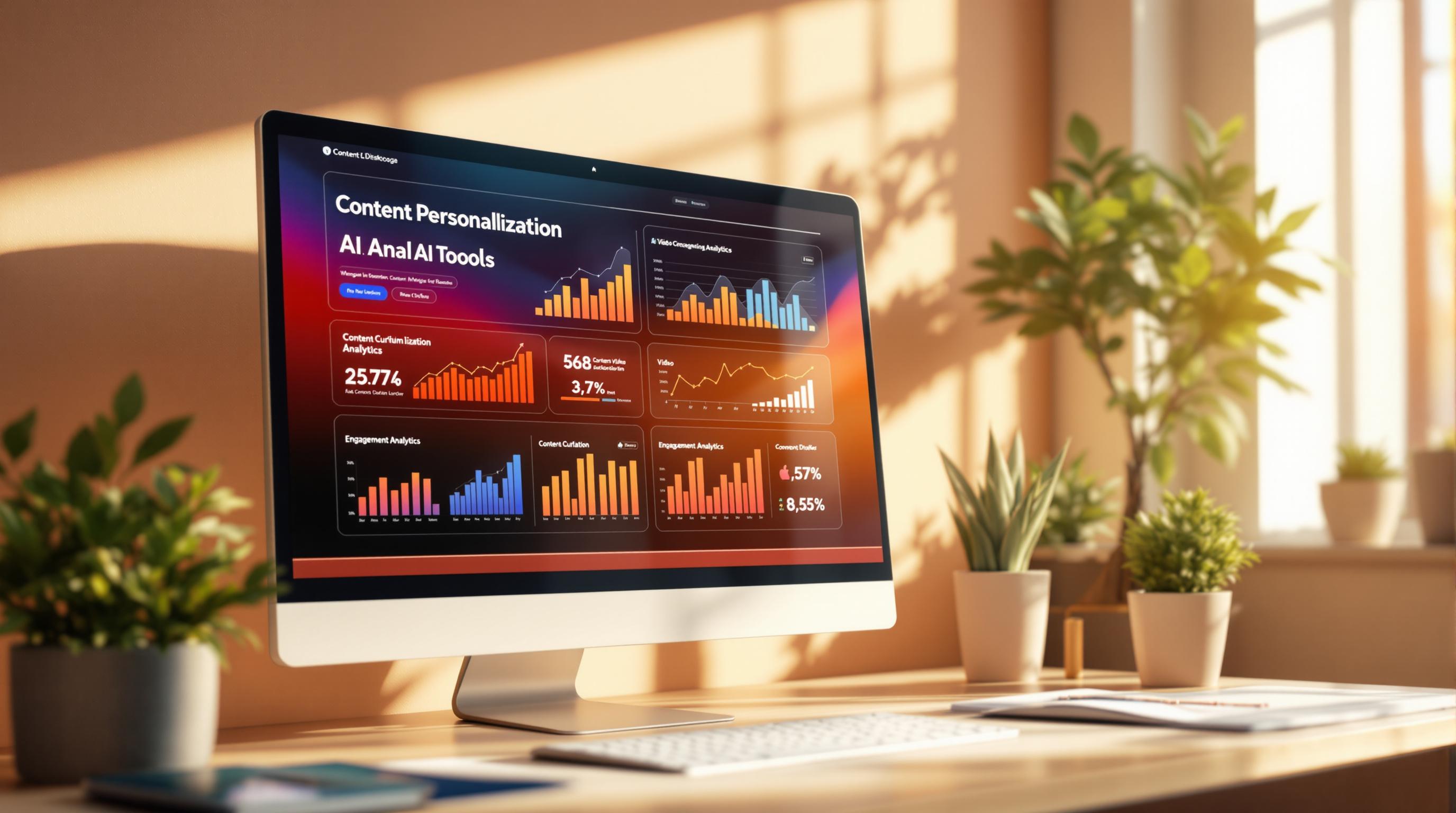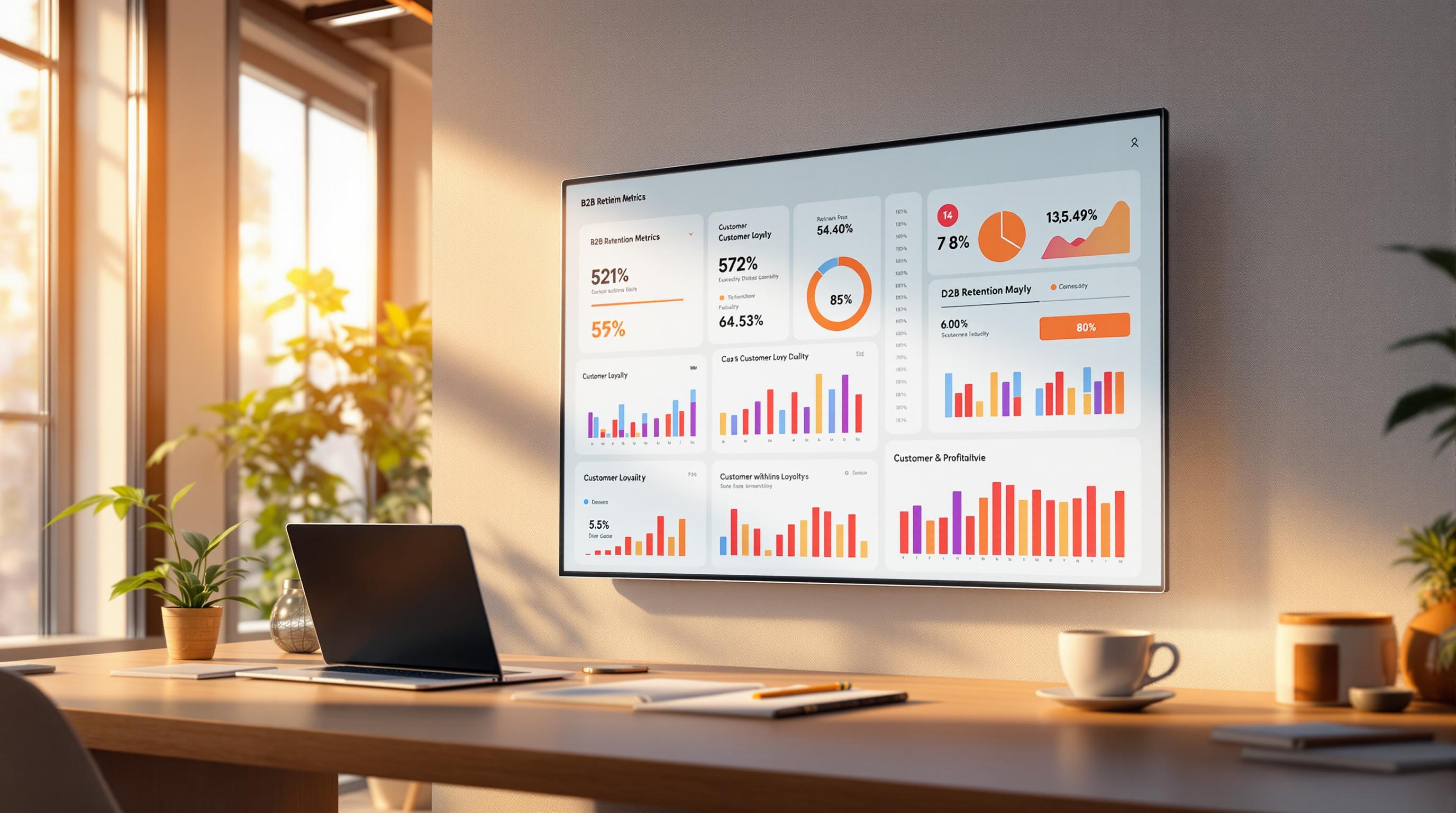Want to know if your personalization strategies are working? Start by tracking these 9 key metrics:
-
Conversion Rate: Measures how many visitors complete a desired action (e.g., purchase, sign-up) after interacting with personalized content.
- Example: Compare personalized vs. standard conversion rates to assess ROI.
-
Click-Through Rate (CTR): Tracks how often users click personalized content (like emails or ads).
- Example: Personalized emails can boost CTR by over 100%.
-
Average Order Value (AOV): Shows how personalization impacts customer spending per order.
- Example: Tailored product recommendations can increase AOV.
-
Customer Lifetime Value (CLV): Evaluates the total revenue a customer brings over time.
- Example: Personalized experiences often lead to higher CLV.
-
Engagement Rate: Measures how users interact with personalized content (e.g., time spent, social shares).
- Example: Real-time personalization can improve engagement.
-
Customer Retention Rate: Indicates how well personalization keeps customers coming back.
- Example: Behavioral triggers like cart reminders can boost retention.
-
Return on Investment (ROI): Assesses financial returns from personalization efforts.
- Example: A $50,000 investment yielding $150,000 in revenue equals 200% ROI.
-
Net Promoter Score (NPS): Measures customer loyalty and likelihood to recommend your brand.
- Example: Promoters (9-10 ratings) often result from successful personalization.
-
Customer Satisfaction Score (CSAT): Gauges immediate satisfaction with personalized interactions.
- Example: Surveys after tailored experiences can highlight areas for improvement.
Quick Tip: Start by focusing on metrics that align with your business goals (e.g., CLV for retention or CTR for engagement). Use these insights to refine your strategies and maximize impact.
Key Metrics for Personalization #ai #artificialintelligence ...
1. Conversion Rate
Conversion rate measures how many visitors complete a desired action after interacting with personalized content. It's a direct link between your personalization efforts and business results, whether that's purchases, sign-ups, or other key actions.
How to Calculate: Take the number of conversions, divide it by the total number of visitors, and multiply by 100. For example, if 500 out of 10,000 visitors make a purchase, your conversion rate is 5%.
Key Metrics to Watch:
- Overall conversion rate: Tracks baseline performance for all visitors.
- Personalized segment conversion rate: Focuses on visitors who experience tailored content.
- Control group conversion rate: Measures results for those seeing standard, non-personalized content.
To see how well personalization is working, compare the conversion rates of personalized experiences against standard ones. This helps identify the return on investment (ROI) of your strategy. Check out the table below for an example:
| Visitor Segment | Visitors | Conversions | Rate |
|---|---|---|---|
| Personalized | 10,000 | 800 | 8.0% |
| Standard | 10,000 | 400 | 4.0% |
| Improvement | - | +400 | +100% |
Tips for Better Tracking:
- Set specific goals for different customer segments and keep tabs on performance across devices and channels.
- Monitor micro-conversions (like "add to cart") alongside final conversions.
- Break down conversion rates by funnel stage, traffic source, demographics, purchase history, location, and time of day.
Keep in mind, conversion rates are about more than just the numbers. Pay attention to the quality of conversions. A smaller group of high-value customers can often be worth more than a larger group of low-value ones. Use these insights to fine-tune your approach and maximize ROI.
2. Click-Through Rate (CTR)
CTR is an early indicator of how well your audience responds to personalized content. It measures how often people click on your content compared to how many see it.
How to Calculate: Divide the number of clicks by the number of impressions, then multiply by 100. For example, if you get 250 clicks from 5,000 impressions, your CTR is 5%.
Key Areas to Track:
- Email campaigns
- Product recommendations
- Website content
- Banner ads
Take a look at how personalization can boost CTR across different channels:
| Channel | Standard CTR | Personalized CTR | Improvement |
|---|---|---|---|
| 2.1% | 4.8% | +128.6% | |
| Homepage Banner | 1.3% | 3.2% | +146.2% |
| Product Recommendations | 0.8% | 2.5% | +212.5% |
| Retargeting Ads | 0.9% | 2.7% | +200.0% |
Tips to Improve CTR:
- Keep an eye on performance across different devices and platforms.
- Experiment with various personalization strategies, like using names, behavior patterns, or locations.
- Pay attention to timing - both time of day and day of the week can influence results.
- Break down CTR by customer segments or lifecycle stages.
- Connect CTR data to conversions to measure its real impact.
- Study how different customer groups respond to personalized content.
A high CTR is great, but it’s only meaningful if those clicks lead to valuable actions, like purchases or sign-ups. If clicks aren’t translating into results, it might be time to adjust your targeting.
Next, we’ll see how Average Order Value (AOV) takes these engagement signals a step further by focusing on revenue.
3. Average Order Value (AOV)
AOV shows how personalized experiences encourage customers to spend more.
How to calculate it: Divide your total revenue by the number of orders. For instance, if your business earns $100,000 from 1,000 orders, your AOV would be $100.
Boosting AOV: Personalization strategies like tailored product recommendations, custom bundles, dynamic pricing, and unique landing pages can make a big difference.
To track AOV effectively, compare different customer segments, monitor performance across channels (like your website, email, mobile app, or in-store), and study how it changes over time, especially before and after implementing personalization.
Ways to improve AOV:
- Build tailored product bundles
- Use dynamic cross-selling techniques
- Offer loyalty rewards based on individual preferences
- Experiment with different price points
- Integrate AI-driven recommendations
Watch out for these issues:
- A higher AOV but fewer purchases overall
- Lower customer satisfaction levels
- Certain customer segments falling behind in performance
For a clearer picture of personalization’s impact, analyze AOV alongside conversion rates and Customer Lifetime Value (CLV). Up next: CLV, which helps you understand the long-term effects of personalization.
4. Customer Lifetime Value (CLV)
Customer Lifetime Value (CLV) represents the total revenue a business can expect from a customer throughout their relationship. It helps determine if personalized experiences are leading to stronger, long-term connections.
How to calculate CLV: Multiply the average purchase value by the average purchase frequency and the average customer lifespan. For example, if a customer spends $100 per purchase, buys 4 times a year, and stays for 3 years, their CLV would be $1,200.
Factors that influence CLV:
- How often customers make purchases
- The average amount spent per transaction
- How long customers remain active
- Costs for acquiring new customers
- Support and service-related expenses
Tracking personalization’s effect on CLV:
Compare CLV across customer groups - those experiencing personalized interactions versus those who don’t. Metrics to watch include:
- Frequency of repeat purchases
- Time intervals between purchases
- Spending habits across various channels
- Interaction with tailored recommendations
- Engagement with custom content
Tips for improving CLV:
- Group customers by their behaviors
- Launch focused retention campaigns
- Offer loyalty programs tailored to individual preferences
- Regularly gather and act on customer feedback
- Refine personalization efforts using CLV insights
Avoid these CLV calculation mistakes:
- Overlooking the cost of acquiring customers
- Ignoring seasonal shifts in buying habits
- Failing to segment customers effectively
- Underestimating the role of customer service
- Relying on outdated or incomplete data
sbb-itb-a84ebc4
5. Engagement Rate
Engagement rate measures how users interact with personalized content, offering insights into their behavior beyond conversion metrics.
Here are key engagement signals to monitor:
- Time spent on personalized pages
- Scroll depth on customized content
- Social interactions, like shares and comments
- Email metrics, such as open and click rates
- Video completion rates
- Form submissions
To calculate engagement rate, divide the number of interactions by impressions (or reach) and multiply by 100. For instance, if a personalized landing page gets 300 interactions from 6,000 visitors, the engagement rate is 5%.
How to Boost Engagement with Personalization:
- Real-time personalization: Show dynamic content that changes based on user behavior.
- Cross-platform consistency: Ensure personalization is uniform across all channels.
- Interactive tools: Use quizzes or assessments tailored to user preferences.
- AI-driven chatbots: Provide tailored responses based on users' past activity.
Tracking these metrics helps fine-tune your personalization efforts and uncover deeper insights into user behavior. Up next, we’ll explore how engagement ties into long-term success through Customer Retention Rate.
6. Customer Retention Rate
Retention rate tells you how effective your personalization efforts are in encouraging repeat business and increasing profits.
To calculate it, use this formula: ((End Customers - New Customers) ÷ Starting Customers) × 100.
Personalization Strategies to Boost Retention
- Behavioral Triggers: Send personalized content like product recommendations or cart reminders based on customer actions.
- Lifecycle Marketing: Match your communication to where customers are in their journey, from onboarding to loyalty rewards.
- Cross-Channel Personalization: Ensure a seamless, personalized experience across your website, app, and email.
Tips for Retention Through Personalization
- Dynamic Content: Adjust website content in real time based on user behavior.
- Marketing Automation: Use automated tools to guide leads and personalize their journey.
- Interactive Content: Use quizzes and surveys to gather insights directly from customers.
Monitor these efforts closely. Look at repeat purchase rates, time between purchases, satisfaction scores, and engagement levels. Break down the data by customer groups, channels, and strategies to identify what’s working best.
7. Return on Investment (ROI)
ROI helps determine whether your personalization strategies are delivering measurable business results by comparing the financial returns to the costs involved.
How to Calculate Personalization ROI
The formula for ROI is: ((Revenue - Cost) ÷ Cost) × 100.
For instance, if you spent $50,000 on personalization tools and earned $150,000 in additional revenue: ($150,000 - $50,000) ÷ $50,000 × 100 = 200% ROI.
Key Cost Components to Track
When calculating costs, make sure to include:
- Tools and software for personalization
- Implementation and system integration
- Creating and managing content
- Collecting and analyzing data
- Training staff
- Ongoing upkeep and support
Revenue Attribution Methods
To link revenue directly to personalization efforts, use these methods:
- A/B Testing: Compare outcomes between personalized and non-personalized experiences.
- Segment Analysis: Track revenue shifts in specific customer groups.
- Campaign Attribution: Measure sales from campaigns with personalized content.
- Customer Journey Analysis: Evaluate how personalization impacts interactions across different touchpoints.
Tips to Boost ROI
- Focus on Data Accuracy: Use reliable customer data for better targeting.
- Leverage Automation: Save time with automated personalization processes.
- Start Small: Begin with high-impact segments, then expand as results improve.
- Continuous Testing: Regularly refine personalization strategies and content.
Keep an eye on both immediate returns and long-term benefits like higher customer lifetime value and retention rates.
Measuring Indirect Benefits
Don’t overlook secondary advantages, such as:
- Lower customer acquisition costs
- Better customer satisfaction scores
- Stronger brand loyalty
- Reduced support expenses
- Increased operational efficiency
Up next, we’ll explore how to gauge customer sentiment using Net Promoter Score (NPS).
8. Net Promoter Score (NPS)
Net Promoter Score (NPS) is a key way to measure customer sentiment, going beyond financial metrics. It shows how likely customers are to recommend your personalized experiences, offering insight into the impact of your efforts.
Breaking Down NPS Categories
NPS divides customers into three groups based on their answer to the question: "How likely are you to recommend our personalized experience to others?" (rated on a scale of 0–10):
- Promoters (9-10): Loyal customers who actively recommend your brand.
- Passives (7-8): Content but not enthusiastic - unlikely to promote your brand.
- Detractors (0-6): Unhappy customers who may warn others away.
How to Calculate NPS
The formula is simple: % Promoters - % Detractors = NPS
Here’s an example:
- 45% Promoters
- 35% Passives
- 20% Detractors
NPS = 45% - 20% = 25
This score helps you understand customer advocacy and adds depth to your performance metrics.
Using NPS to Evaluate Personalized Experiences
To make the most of NPS, segment your data by personalized versus non-personalized experiences. Track it after key customer interactions like product recommendations, email campaigns, purchases, and service calls.
Steps to Improve NPS Through Personalization
Want to boost your NPS? Focus on these areas:
- Keep your data clean and accurate.
- Send personalized content at the right time.
- Ensure consistency across all channels.
- Act quickly on customer feedback.
Avoiding NPS Mistakes
Watch out for these common issues:
- Overloading customers with surveys.
- Ignoring factors outside your control.
- Taking too long to address negative feedback.
- Failing to fully analyze your results.
Monitoring NPS over time gives you a clear picture of how personalization impacts customer loyalty. Up next, we’ll dive into how the Customer Satisfaction Score (CSAT) can add even more clarity.
9. Customer Satisfaction Score (CSAT)

CSAT provides quick feedback on how satisfied customers are with personalized experiences. Unlike NPS, which measures long-term loyalty, CSAT focuses on immediate reactions to specific interactions.
How CSAT Is Measured
CSAT surveys usually ask something like: "How satisfied were you with this personalized experience?" Customers respond on a 1–5 scale:
- 1: Very Dissatisfied
- 2: Dissatisfied
- 3: Neutral
- 4: Satisfied
- 5: Very Satisfied
The formula for CSAT is simple:
CSAT = (Satisfied responses ÷ Total responses) × 100
Once you calculate your score, focus on identifying key moments where personalized interactions affect satisfaction.
Personalization Points to Monitor for CSAT
Measure CSAT at these interaction points to understand how personalization impacts customer satisfaction:
- Product suggestions tailored to individual preferences
- Customized email campaigns
- Personalized landing pages
- Dynamic pricing or offers
- Interactions with customer service tailored to the individual
Boosting CSAT with Enhanced Personalization
To improve your CSAT scores, consider these steps:
- Ensure Data Accuracy: Regularly check and update your data to avoid errors in personalization.
- Speed Matters: Deliver personalized content promptly to prevent frustration.
- Be Context-Aware: Match timing and channels to customer preferences for more effective messaging.
Avoiding Common CSAT Mistakes
Here are some pitfalls to watch out for:
- Don’t overwhelm customers with too many surveys.
- Collect feedback immediately after interactions for accurate responses.
- Look at both positive and negative feedback for a complete picture.
- Break down CSAT data by personalization type to uncover specific areas for improvement.
Monitoring CSAT Over Time
Start by establishing a baseline CSAT score before rolling out new personalization efforts. Then, track your score monthly to see how changes impact customer satisfaction. This helps pinpoint which strategies work best and where adjustments are needed.
CSAT adds another layer of insight, giving you real-time feedback on how well your personalization efforts are resonating with customers.
Conclusion
Measuring personalization success involves bringing together nine key metrics to get a complete picture. These metrics aren’t standalone - they work as a system to evaluate and improve personalization efforts throughout the customer journey.
How Metrics Work Together
Each metric plays a distinct role in understanding personalization:
- Top-of-Funnel Metrics like click-through rates (CTR) and engagement rates highlight the initial impact of your efforts.
- Mid-Funnel Metrics such as conversion rates and average order value (AOV) show how personalization contributes to immediate business results.
- Bottom-Funnel Metrics like customer lifetime value (CLV) and retention rates gauge long-term effectiveness.
- Voice-of-Customer Metrics such as Net Promoter Score (NPS) and customer satisfaction (CSAT) offer direct feedback on the quality of personalization.
Together, these metrics provide a roadmap for fine-tuning strategies based on data.
A Framework for Data-Driven Optimization
To get the most out of personalization, follow a structured process:
1. Establish Baselines
Monitor each metric over a period of at least three months to create dependable benchmarks.
2. Set Clear Goals
Tie metrics to your broader business priorities. For instance, if retaining customers is a focus, emphasize CLV and retention rates.
3. Track and Adjust
Regularly review performance trends and tweak your strategies as needed.
New Tools on the Horizon
While these metrics are effective, new tools are making personalization measurement even better:
- AI Analytics: Machine learning can now predict how well personalization efforts will perform before they’re even launched.
- Real-Time Optimization: Advanced tools allow for instant adjustments based on live performance data.
- Cross-Channel Attribution: Improved tracking across multiple touchpoints helps clarify the return on investment (ROI).
Final Tips
Don’t try to measure everything. Instead, focus on metrics that align with your business goals. Build a balanced strategy that:
- Uses both numbers (CTR, conversion rates) and customer feedback (NPS, CSAT).
- Tracks short-term wins while keeping an eye on long-term growth.
- Evolves with customer needs and new technology.
- Leverages data to continuously improve personalization efforts.


